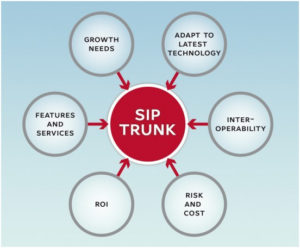SIP Phone Service Overview
What is SIP Trunking?
SIP trunking is a method of delivering telephone and other unified communications services over the Internet to customers that have SIP enabled private branch exchange (IP-PBX) solutions. SIP utilizes both Voice over Internet Protocol (VoIP) and Session Initiation Protocol (SIP) and it replaces traditional telephone lines or PRIs (Primary Rate Interface).
How do SIP Trunks Work?
Traditional business phone systems consist of two key components. The PBX, which provides call management and features such as Auto Attendants and voicemail, and the PRI lines which connect calls to the PSTN (Public Switched Telephone Network) where they are routed to the destination telephone. When SIP trunks are utilized, the IP enabled PBX connects to the data network instead of the PRI lines and the voice traffic travels the Internet to connect to the PSTN. SIP Trunks can also be used with analog adapters or SIP-to-T1 gateways, allowing you to keep your legacy PBX equipment and take advantage of lower telecom costs.
where they are routed to the destination telephone. When SIP trunks are utilized, the IP enabled PBX connects to the data network instead of the PRI lines and the voice traffic travels the Internet to connect to the PSTN. SIP Trunks can also be used with analog adapters or SIP-to-T1 gateways, allowing you to keep your legacy PBX equipment and take advantage of lower telecom costs.
Why do Businesses Choose SIP Phone Service?
While there are many advantages to the VoIP SIP trunk approach, the primary drivers are cost and flexibility. SIP trunking eliminates the need for PRI lines and the associated cost. Unlike PRI lines, which contain 23 channels, SIP trunks can be purchased in increments as low as one channel, or one concurrent call. This gives businesses the ability to purchase and pay for only what they need and to easily scale as capacity requirements change.
